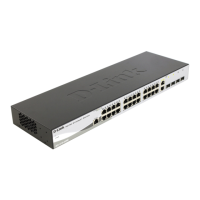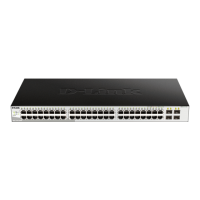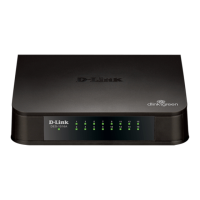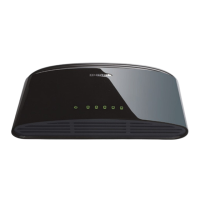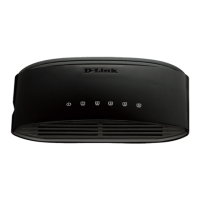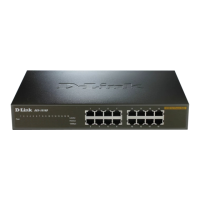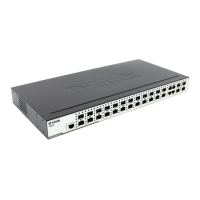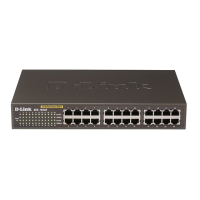Do you have a question about the D-Link DES-1228/ME and is the answer not in the manual?
Lists the supported IEEE standards and features of the Switch.
Details the types of ports available on the switch, including specifications and compatibility.
Explains the function of each LED indicator on the switch for status monitoring.
Provides a description of the components and indicators on the front panel of the switch.
Guides on how to install SFP ports for fiber-optic transceiver cabling.
Lists the items included in the shipping carton of the switch.
Provides guidelines for setting up the switch, including site requirements.
Instructions for installing the switch on a desktop or shelf.
Guidance on mounting the switch in a standard 19" rack.
Details on connecting PCs or routers to the switch using twisted-pair cables.
Explains how to connect the switch to hubs or other switches using various cable types.
Describes how to access and use the switch's web-based management interface.
Instructions for connecting to the switch via the console port for monitoring and configuration.
Details on how to set up user accounts and passwords for switch security.
Explains how to configure the switch's IP address for network management.
Steps to access the switch's management interface via a web browser.
Overview of the main areas and functions within the web manager interface.
Configuration of the switch's IP address, subnet mask, and default gateway.
Settings for individual physical ports, including speed, duplex, and flow control.
Managing user privileges and access rights for switch management.
Configuration of SNMP settings for network monitoring and management.
Controls traffic flow, including unicast, multicast, and filtering settings.
Configuration for sending switch events via email.
Configuration and management of Virtual Local Area Networks for network segmentation.
Configuration of Spanning Tree protocols to prevent network loops and ensure fault tolerance.
Optimizes multicast traffic by snooping IGMP messages.
Enables discovery of network topology and device information using LLDP.
Controls and limits the data rates for transmitting and receiving on selected ports.
Assigns a default 802.1p priority to each port on the switch.
Establishes criteria to determine packet forwarding based on header information.
Applies access rules to packets destined for the switch's CPU interface.
Monitors and controls network traffic, including packet storm detection and mitigation.
Secures ports by locking MAC addresses to prevent unauthorized access.
Configures Secure Shell for secure remote login and network services.
Implements port-based and host-based access control for network authentication.
Permits specific remote stations to manage the switch based on IP addresses.
Displays the percentage of CPU usage, calculated as a simple average over time.
Shows the percentage of total available bandwidth being used on each port.
Allows viewing of various packet statistics, including received and transmitted data.
Displays port error statistics, compiled by the switch's management agent.
Provides a history of events and system messages logged by the switch.
Lists the networking protocols supported by the switch hardware.
Details the switch's performance metrics like forwarding rate and switching capacity.
Details D-Link's warranty for material defects in the hardware portion of the product.
Outlines D-Link's warranty for the software portion of the product.
Provides contact information and resources for technical assistance from D-Link.
Lists the supported IEEE standards and features of the Switch.
Details the types of ports available on the switch, including specifications and compatibility.
Explains the function of each LED indicator on the switch for status monitoring.
Provides a description of the components and indicators on the front panel of the switch.
Guides on how to install SFP ports for fiber-optic transceiver cabling.
Lists the items included in the shipping carton of the switch.
Provides guidelines for setting up the switch, including site requirements.
Instructions for installing the switch on a desktop or shelf.
Guidance on mounting the switch in a standard 19" rack.
Details on connecting PCs or routers to the switch using twisted-pair cables.
Explains how to connect the switch to hubs or other switches using various cable types.
Describes how to access and use the switch's web-based management interface.
Instructions for connecting to the switch via the console port for monitoring and configuration.
Details on how to set up user accounts and passwords for switch security.
Explains how to configure the switch's IP address for network management.
Steps to access the switch's management interface via a web browser.
Overview of the main areas and functions within the web manager interface.
Configuration of the switch's IP address, subnet mask, and default gateway.
Settings for individual physical ports, including speed, duplex, and flow control.
Managing user privileges and access rights for switch management.
Configuration of SNMP settings for network monitoring and management.
Controls traffic flow, including unicast, multicast, and filtering settings.
Configuration for sending switch events via email.
Configuration and management of Virtual Local Area Networks for network segmentation.
Configuration of Spanning Tree protocols to prevent network loops and ensure fault tolerance.
Optimizes multicast traffic by snooping IGMP messages.
Enables discovery of network topology and device information using LLDP.
Controls and limits the data rates for transmitting and receiving on selected ports.
Assigns a default 802.1p priority to each port on the switch.
Establishes criteria to determine packet forwarding based on header information.
Applies access rules to packets destined for the switch's CPU interface.
Monitors and controls network traffic, including packet storm detection and mitigation.
Secures ports by locking MAC addresses to prevent unauthorized access.
Configures Secure Shell for secure remote login and network services.
Implements port-based and host-based access control for network authentication.
Permits specific remote stations to manage the switch based on IP addresses.
Displays the percentage of CPU usage, calculated as a simple average over time.
Shows the percentage of total available bandwidth being used on each port.
Allows viewing of various packet statistics, including received and transmitted data.
Displays port error statistics, compiled by the switch's management agent.
Provides a history of events and system messages logged by the switch.
Lists the networking protocols supported by the switch hardware.
Details the switch's performance metrics like forwarding rate and switching capacity.
Details D-Link's warranty for material defects in the hardware portion of the product.
Outlines D-Link's warranty for the software portion of the product.
Provides contact information and resources for technical assistance from D-Link.
| Brand | D-Link |
|---|---|
| Model | DES-1228/ME |
| Category | Network Router |
| Language | English |
